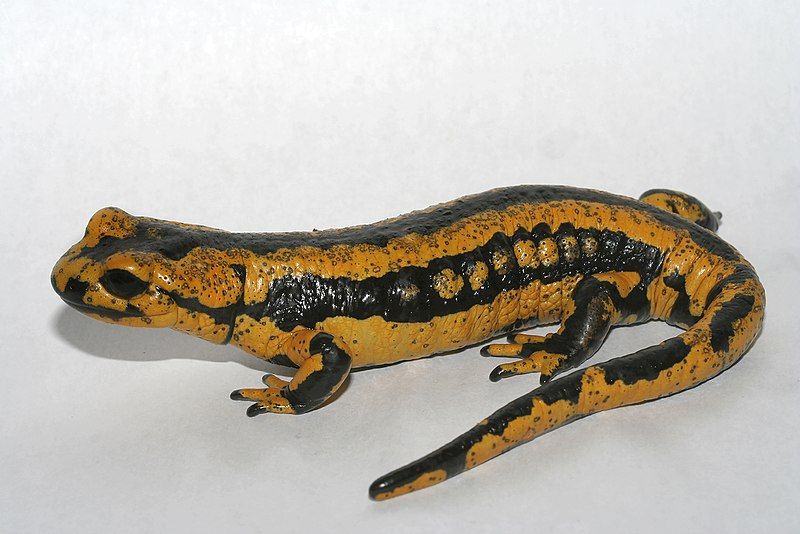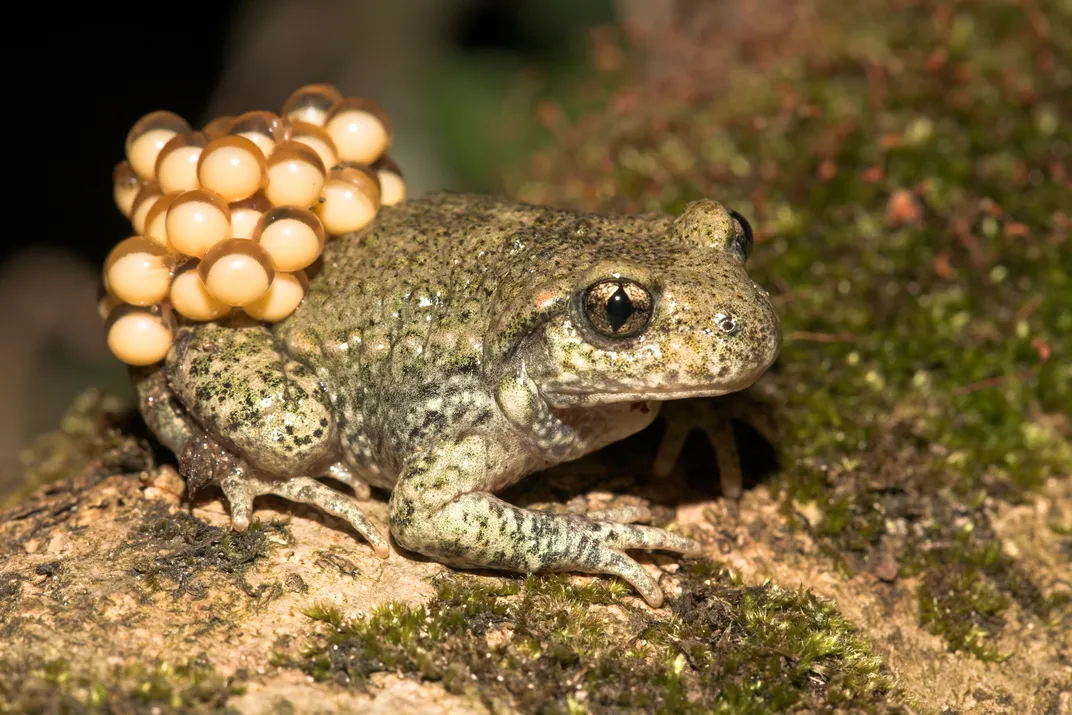How American Scientists Are Planning to Thwart a Salamander Apocalypse
Yet another fungus threatens to decimate amphibians in North America, but this time, scientists stand ready
/https://tf-cmsv2-smithsonianmag-media.s3.amazonaws.com/filer/f2/c3/f2c3716e-cdda-4d2b-ad45-e2ef2b8bf4b9/fire_salamander.jpg)
They didn’t see it coming.
By the time scientists discovered the first outbreak of chytridiomycosis, a disease caused by a fungus called Bd, it was too late; worldwide, the pathogen had already begun tanking populations of some 200 species of frogs that have gone extinct since the 1970s.
That was then. Now, another closely-related fungus called Bsal threatens to release a new wave of chytridiomycosis on amphibians—and this time, salamanders are the target. Though Bsal remains isolated in Asia and Northern Europe, researchers say it’s only a matter of time before it reaches the United States, home to the world’s highest salamander diversity.
But when the new pathogen strikes, scientists won’t be caught off guard.
With the devastating impacts of Bd still fresh in their minds, they’ve mounted a defense against Bsal—a volunteer-led task force, comprised of researchers from academia, government and nonprofits, that’s been preparing for the pathogen’s arrival for years.
“We’re preparing ourselves enough so we can pounce on it when it’s detected—and maybe actually contain it,” says Priya Nanjappa, a program manager at the Association of Fish and Wildlife Agencies, who’s a core part of the response effort. “The potential for impact is immense.”
Whether their efforts will be enough to prevent another amphibian epidemic in the U.S., however, hinges on how quickly they can detect an initial outbreak. And even if they are prepared, Nanjappa says, “it’s definitely going to be an experiment when it gets here.”
A perfect pathogen
The emerging pathogen Bsal is like something out of the Ridley Scott movie Alien. Like its relative Bd, spores ejected into the environment latch onto the skin of a host—in this case, at least a few dozen species of salamanders, research suggests—and then begin to consume the amphibian’s skin to build root-like masses and “mother cells,” which fire off even more spores. The salamander dies in as little as a week as a result, but not before the fungus multiplies and seeks out additional hosts.

The potential impact of Bsal was evident when it first arrived in the Netherlands, likely through the pet trade from Asia where it’s believed to be native. There, the pathogen wiped out 96 percent of the resident population of fire salamanders in a few years. And it’s since been discovered in wild populations of other species like the alpine newt in neighboring countries.
The pathogen now appears to be spreading—both in the wild and through the pet trade, experts say.
“We’ve seen several instances of it moving through the pet trade in Europe,” says Katie Richgels, chief of the Applied Wildlife Health Research Branch of the National Wildlife Health Center. “The pet trade is by far the biggest reason why we’re moving amphibians around.”
As a precautionary measure, the U.S. Fish and Wildlife Service placed an import ban on 201 salamander species thought to be potential vectors of the disease in 2016. These species were listed as “injurious” to wildlife under the Lacey Act—rarely used to thwart wildlife diseases—restricting their importation and interstate movement.
But even a ban won’t be enough to block Bsal’s arrive, says Stefano Canessa, a research fellow at Ghent University in Belgium, who’s been involved in mitigating the pathogen’s impact in Europe. It will find a way here, he says, if not through trade, then through an agriculture stow-away or the mud on the bottom of a hiker’s boot.
“Due to the size of the trade and the numbers we’re playing with, introduction is basically a certainty,” he says. “It will come in if it’s not already there.”
Scientists in the U.S. are worried.
In many ways, Bsal is a perfect pathogen, they say. It’s not only highly virulent—its effects are severe and swift—but it can also persist in the environment for days without a host. It can even be carried on the feet of wading birds, research shows, which could further aid its spread.
There’s another reason why Bsal is so nasty: While the pathogen may be lethal to at least 60 species of salamanders in the U.S., scientists believe that other species—like the midwife toad and the alpine newt—can carry Bsal yet remain asymptomatic. In other words, they serve as “reservoirs” for the disease.
“They don’t get sick, but they’re spreading it to those that are susceptible,” Richgels says. “In the disease world, that’s really hard to manage.”
But scientists in the U.S. do have an advantage that offers a glimmer of hope: time and experience.
Preventing a pandemic
When Bd was first described in 1999, it was already at work for nearly two decades, scientists say, lethally infecting frogs in a similar way to how Bsal infects salamanders; the two fungi are in the same genus, Batrachochytrium, and they both produce the disease chytridiomycosis. At the time, researchers knew little about the disease’s pathology and how to prevent it from spreading.
That’s what makes the emergence of Bsal so unique. Scientists in the U.S. not only have time ahead of its arrival to prepare, but they also have a general idea of what to expect.
“We have a huge toolkit now,” says Jake Kerby, a biologist at the University of South Dakota who’s been working on Bd for a decade. And it includes “the ability to very quickly assess the presence of these diseases.”
“That’s a huge advantage,” he adds.
In 2015, a group of scientists, government officials and other researchers seized the opportunity. Motivated in part by fear—many having witnessed the impacts of Bd and other wildlife diseases like white-nose syndrome—they formed the country’s greatest defense against another chytridiomycosis epidemic: The National Bsal Task Force.
Sure, it’s not as sexy as the Avengers, but for the country’s salamanders, which play a critical role in any environment, from transporting nutrients between habitats to feeding other species, they are indeed superheroes.
Their goal is simple: Prevent Bsal from spreading among salamander populations in the U.S.
Central to that mission is a 30-page emergency response plan, published in June. It reads something like a guidebook for a zombie outbreak: “Individual quarantine for all potentially exposed animals until causative agent is determined,” reads one step. “Restricted public access to the exposed area(s).”
“The response plan has an exhaustive list of scenarios,” says Reid Harris, co-lead of the task force, from discovering a confirmed case of Bsal in the wild to hearing about a sick salamander in captivity. Now that the plan is drafted, the next step is helping state wildlife agencies understand and be ready to implement the plan, he says.
The plan isn’t designed to stop the pathogen altogether, Nanjappa says. Rather, it’s meant to minimize the pathogen’s reach and, in doing so, buy the task force time to come up with treatment or a cure.
“Right now we don’t have an answer to Bsal, but that doesn’t mean we won’t,” Richgels says. “If we find it early there are things we can do to slow the spread, which gives us time to find answers—treatments, cures and whether there’s some way to treat the environment.”

Indeed, there are still massive gaps in research, Kerby says. Scientists need to better understand which species of salamanders in the U.S. are susceptible to Bsal—and to what extent. Without knowing which kinds of salamanders are most vulnerable to the disease (and which are already at risk from other pressures like habitat loss), he says, it’s difficult to efficiently allocate resources.
Kerby and other researchers are also scrambling to find ways to rid the pathogen permanently. While they’ve already learned that the right combination of temperature and antifungal agents could treat individual salamanders—in part, thanks to previous work on Bd—a treated salamander could simply walk back into the environment and contract the disease again.
But there’s a new line of research that’s showing promise: “probiotics.”
Not all species of salamanders are susceptible to chytridiomycosis, research has shown, and scientists believe that natural immunity is linked to beneficial bacteria found on amphibians’ skin. In other words, some salamanders may have a microbial army, of sorts, ready to fight off Bsal as it starts to invade. If researchers can identify what the soldiers look like—what kind of bacteria they are, that is—they might be able to create a “probiotic bath” for salamanders.
But they’re still far from a cure. Until one’s developed, scientists are on high alert for sick or dead salamanders, especially in the Appalachian Mountains and Pacific Northwest, where their diversity is greatest.
“Any suspicious-appearing amphibians should be investigated,” the plan says. It goes on to describe symptomatic animals as “sick or lethargic individuals, those with black circular or oblong lesions, or inability to right themselves.”
Scientists still worry they won’t discover the disease right away, even with state wildlife agencies on the ready, armed with a response plan. The area over which Bsal could invade is vast and the resources for surveillance are limited, they say.
That’s why it’s so important that everyone, including the general public, assist in the hunt, Canessa says. “There are lots of people out there like hikers that could report Bsal,” he says. “To harness that potential is our best bet.”
To that end, Partners in Amphibian and Reptile Conservation, a network of nonprofits, federal agencies and other institutions dedicated to the conservation of herpetofauna, launched an email-based disease alert system last summer. They encourage everyone to report signs of Bsal.
“We want reports of apparently sick, dying or dead animals with disease signs,” Dede Olson, an ecologist with the U.S. Forest Service, said in a press release. “It would help if the greater community of nature enthusiasts and recreationists would report their observations of disease events, as these can be cryptic and go unnoticed.”
A few recent reports have been unnerving, Nanjappa says, including one about salamanders with lesions on their skin. But tests revealed all of them to be false alarms—still, there’s no sign of Bsal in the United States.
“As far as far as we know, nothing has come back with a Bsal positive,” she says. “That’s great news, absolutely.” But, from here, it’s a question of when—not if—the disease will arrive.
“I’m nervous,” Nanjappa says.